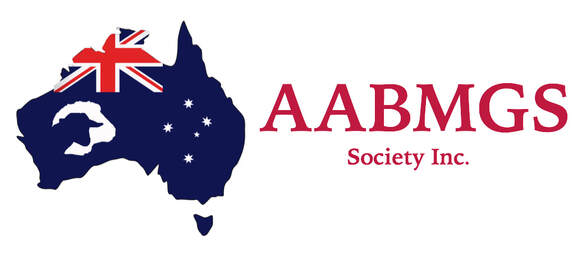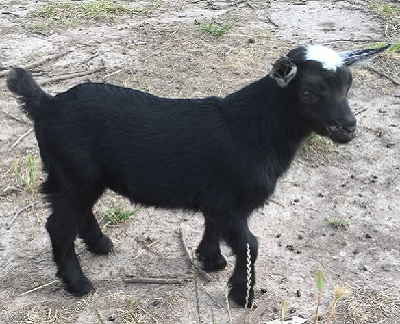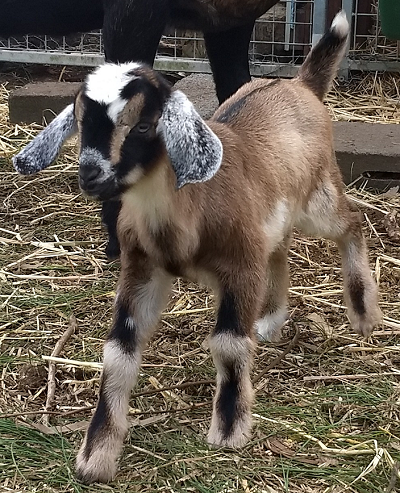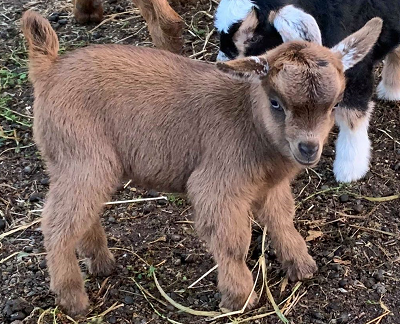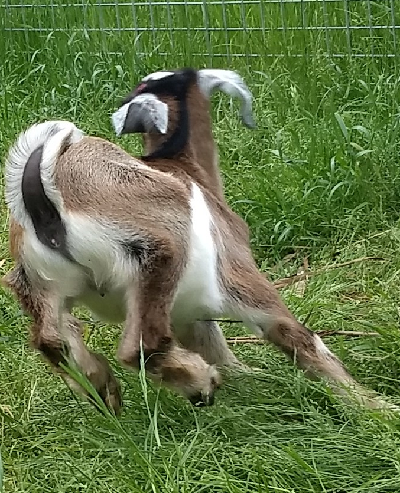Describing the coat colour and pattern of a goat
|
Goats come in a huge range of colours and these colours can be arranged in a number of different patterns.
Some breeds come in only one colour, such as the Australian Melaan which is black all over. Other breeds come in only two colours, such as the British Alpine which is black and white with these colours arranged in a very specific pattern known as "Swiss". The Toggenburg also has the Swiss pattern with the same white markings, but where the British Alpine has black, the Toggenburg has brown or "chocolate". Patterns are generally made up of a combination of two types of pigment - eumelanin and phaeomelanin:
Several breeds allow a range of patterns, the Anglo Nubian breed standard for example allows all patterns except for Swiss. The Nigerian Dwarf and Australian Miniature Goat breed standards allow all colours and patterns. The Pygmy Goat breed standard in the United States allows a limited number of colours and patterns, but the AABMGS has decided that our breed standard for the Pygmy in Australia will not restrict the range of colours and patterns. Even when looking at easily recognisable patterns, one of the first issues that arises is the name of the pattern. There are often several different names for the same pattern. Sometimes different patterns are given the same name in different breeds or different countries, so there is not necessarily a correct name for a specific pattern - we need to agree on what names to use for specific patterns so that we can understand what each other is talking about when we mention a particular pattern by name. What follows is an attempt to create a user-friendly system for naming and identifying some of the main coat colour patterns in goats. There are many patterns, but let's start with some that are easiest to identify because they are identified with particular breeds. Bezoar (wild ancestor of domestic goat) - tan upper body, cream belly and legs extending back to underside of tail and may extend forward to underside of neck. Black on face bordering tan facial stripes, black dorsal stripe, black barring on front of legs. As the male matures the black on the face may extend to cover the tan facial stripes. With maturity the male also develops a black ring around the lower neck and front of shoulders. Oberhasli (also called chamois/chamoisee, badgerface, blackbelly) - tan body, black belly, black legs, black dorsal stripe, black markings on face. With maturity the male also develops a black ring around the lower neck and front of shoulders. Swiss (Toggenburg, British Alpine) - black or chocolate barrel including belly, white facial stripes, white below knees and hocks, white below tail. Sundgau - as for Swiss but with a white belly. San Clemente (buckskin) - black face with tan facial stripes, black cape (i.e. over upper side of neck and shoulders) extending down to just above knee on front legs, black dorsal stripe, also black markings on outside of hind leg from knee to hock. Black markings may extend beyond the range described while maintaining the general pattern.. Black mask - black on face bordering tan facial stripes (these stripes may be concealed in the male by increased blackening of the face as he matures), black dorsal stripe (may be wider than usual dorsal stripe). With maturity the male also develops a black ring around the lower neck and front of shoulders. Black and tan - a common pattern in Australian Anglo Nubians (also called cou clair [clear neck] or peacock) - tan front, black on face, black dorsal stripe, black rump, black lower legs. With maturity the male also develops a black ring around the lower neck and front of shoulders. Grey agouti - a common pattern in the Pygmy goat. ***** Because the coat colour and pattern is determined genetically, it is possible for a goat to have a combination of two distinct patterns, one inherited from each parent. These two patterns do not appear in any random combination such as the face markings from the dam and the body markings from the sire for example, when two patterns are combined in one goat they combine in a very specific and predictable way, so that when a goat displays two coat patterns at once it may be possible to identify both patterns. ***** Patterns are not always easy to identify however, one pattern can sometimes completely conceal another, and any pattern can be completely or partially covered over by white. ***** In addition to the regular patterns of arrangement of eumelanin and phaeomelanin in the examples above |
|
|
Australian All Breeds of Miniature Goat and Sheep Society Inc.
